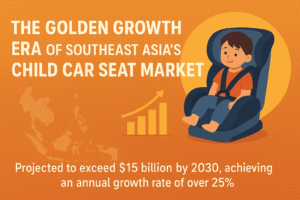Against the backdrop of a gradually recovering global economy and consumption upgrades, the maternal and infant market is seizing unprecedented growth opportunities. Over the next 3-5 years, driven by technological innovation, diversified consumer demands, and accelerated digital transformation, the global maternal and infant market will exhibit new growth drivers and transformation trends. The following analysis delves into various dimensions of the market outlook.
1. Current Market Status and Driving Factors
Market Overview
- Continuous Expansion of Market Scale: Although developed countries face challenges due to low birth rates, emerging markets (such as those in Asia, Africa, and parts of Latin America) continue to experience robust maternal and infant consumption driven by demographic dividends and rapid urbanization.
- Diversification of Products and Services: Maternal and infant products have expanded from traditional baby supplies to include prenatal care, postnatal recovery, smart parenting solutions, and early childhood education services, covering the entire lifecycle.
Driving Factors
- Consumer Upgrades: New generations of parents prioritize health, safety, environmental sustainability, and personalized products, driving the demand for high-quality, value-added products.
- Government and Social Support: Governments worldwide are introducing policies to encourage childbirth and improve childcare services, providing institutional support for market growth.
- Globalization and Cross-border E-commerce: Advancements in internet technology and cross-border e-commerce enable global brands to enter emerging markets more easily, meeting diverse consumer needs.
2. Technological Innovation and Digital Transformation
Digital Marketing and E-commerce Platforms
- Importance of Online Channels: Social media, live-streaming sales, and short video platforms have become crucial bridges between brands and consumers, continuously boosting online sales.
- Data-Driven Decision Making: The application of big data and artificial intelligence allows for a more precise understanding of consumer needs, enabling personalized marketing and optimized supply chain management.
Smart Products and IoT Applications
- Smart Hardware: The gradual adoption of smart monitoring devices, health tracking wearables, and interactive educational toys is enhancing the user experience.
- Ecosystem Building: Maternal and infant brands are striving to build closed-loop ecosystems that include health management, community interaction, and educational services, offering comprehensive parenting support.
3. Consumer Behavior and Market Trends
Consumption Upgrades and Personalized Demand
- Quality and Health: Consumers are increasingly focused on product safety and health, with natural, organic, and additive-free products becoming key purchasing considerations.
- Brand Trust and Word-of-Mouth Marketing: In an era of information transparency, consumers tend to choose brands with strong reputations and robust services, prompting companies to invest more in brand building and user experience optimization.
Social Interaction and Community Economy
- Online Communities: Various parenting forums, groups, and apps allow parents to share experiences and product reviews, creating a strong community economy effect.
- Cross-industry Collaboration: Cross-industry collaborations between maternal and infant brands and sectors like health, education, and entertainment will infuse the market with new vitality and creativity.
4. Major Challenges and Opportunities
Challenges
- Intensified Competition: The market competition is becoming increasingly fierce with the entry of not only traditional brands but also emerging internet enterprises and cross-industry players.
- Regulation and Safety: Issues related to product safety, data privacy, and advertising claims are attracting more regulatory scrutiny, necessitating continuous upgrades in standards to ensure compliance.
- Supply Chain Volatility: Uncertainties in global logistics and supply chains may impact timely product delivery and cost control.
Opportunities
- Potential in Emerging Markets: The rise of the middle class in emerging markets across Asia, Africa, and Latin America offers enormous growth space for maternal and infant consumption.
- Technology Empowerment: Technological innovations in digitalization and smart technology will drive product upgrades and service innovations.
- Policy Support: Policy dividends from countries encouraging childbirth and enhancing childcare support systems will underpin long-term, steady market growth.
5. Strategic Recommendations
Strengthen Digital Transformation
- Multi-channel Layout: Optimize online sales channels, build social e-commerce and content marketing platforms, and leverage big data for refined operations.
- Smart Product R&D: Invest in the research and development of high-tech products such as smart health monitoring and interactive early education solutions to enhance product competitiveness.
Focus on Brand Building and User Experience
- Brand Trust: Establish a robust after-sales service system and user feedback mechanisms to enhance brand credibility and loyalty.
- Community Management: Utilize online communities and parenting forums to build interactive platforms that strengthen user stickiness and community economic effects.
Expand into Emerging Markets
- Localization Strategies: Develop differentiated market strategies tailored to regional consumer habits and demands to achieve precise marketing.
- Win-Win Cooperation: Seek partnerships with local channels, governments, and industry organizations to jointly expand market share.
6. Conclusion
Over the next 3-5 years, the global maternal and infant market is expected to maintain steady growth. Although market competition and external uncertainties persist, technological innovation, consumption upgrades, and policy dividends will continuously drive the industry forward. Enterprises should seize the opportunities offered by digital transformation and cross-industry collaboration, optimize products and services, strengthen brand building, and expand into emerging markets to achieve long-term and robust development.
This report aims to provide comprehensive market insights for businesses and investors, helping them secure a competitive edge in a fiercely competitive environment and propel the global maternal and infant market to new heights.













